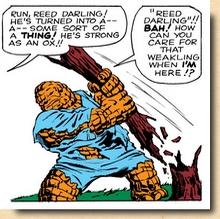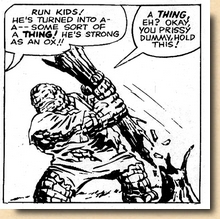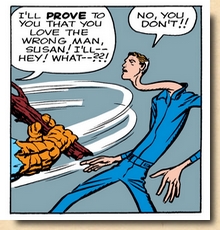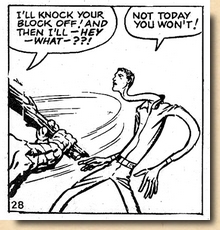| |
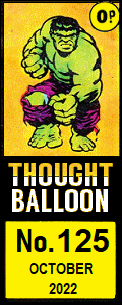 |
  SPOTLIGHT
ON SPOTLIGHT
ON
MIGHTY
WORLD OF MARVEL #1
50
YEARS OF
MARVEL UK
|
|
|
|
| |
|
| |
HULK
"The
Coming of the Hulk"
(10
pages)
Originally published in Incredible Hulk
#1 (May 1962)
Story - Stan Lee
Art - Jack Kirby
Inks - Paul Reinmann
FANTASTIC
FOUR
"The
Fantastic Four"
(13
pages)
Originally published in Fantastic Four #1
(November 1961)
Story - Stan Lee
Art - Jack Kirby
Inks - George Klein
Lettering - Artie Simek
SPIDER-MAN
"Spider-Man"
(10
pages)
Originally published in Amazing Fantasy #15
(September 1962)
Story - Stan Lee
Art & Inks - Steve Ditko
Lettering - Artie Simek
|
|
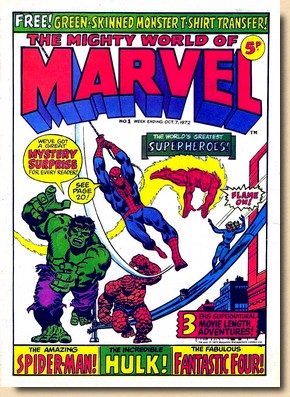 Mighty World Of Marvel #1 Mighty World Of Marvel #1
(UK, October 1972)
|
|
| |
|
| |
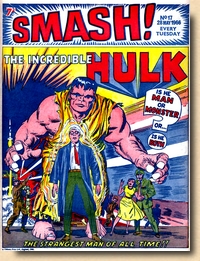
Smash #17
(28 May 1967)
|
|
PRELUDE:
BRITISH MARVEL REPRINTS IN THE 1960s
British comic book readers
had previously been subjected to having Marvel
superhero material reprinted in ways which seemed
haphazard at best.
In the early 1960s, London based Alan Class Comics
started publishing Marvel superhero material, but
in absolutely random order and with no
regard to continuity whatsoever. Readers had no
guarantee that a character would appear in
consecutive issues of a title, or even in the
same title.
Class lost the rights to publish Marvel
characters in 1966 to Odhams Press of
London, a subsidiary of IPC. Marvel superhero
material was reprinted under the banner of
Odham's Power
Comics imprint brand, eventually comprising five weekly titles:
Wham!, Smash!, Pow!, Fantastic
and Terrific.
|
|
| |
Whilst the
first three of these titles featured traditional
British comic book strips with only a small
amount of Marvel material as backup feature
(reproduced to the standard UK comic book market
format, i.e. in black and white and serialized in
weekly installments), Fantastic and Terrific
were more magazine-like in style and featured
mainly Marvel content (Stringer, 2008).
In order to make the
material fit their classic British comics page
size (9.75" x 12", compared to
the standard US 7.125"
x 10.5"),
editors would cut up and rearrange panels (and
sometimes even leave out a few), resulting in
entirely different page layouts.
Odham's even got a
mention in the March 1968 Bullpen Bulletin
(although the actual message was that, in spite
of Odham's reprints, Marvel was still shipping
select US colour titles to the UK news stands), but
their presentation of Marvel material from 1966
to 1968 was rather special.
Whilst editorial copied the
style of Stan Lee's banter heavily, the word
"Marvel" was never spoken (apart from the statutory
copyright notice in small print). Instead,
they referred to themselves as "Power-House"
and told readers about the "progress of
Powerdom". In addition, all five titles
- Wham!, Smash!, Pow!, Fantastic
and Terrific - carried a "Power Comics"
logo that beared absolutely no resemblance to any
Marvel Comics logos.
Ironically, Odham seemed to soon
run out of power, as the five titles were
gradually merged throughout 1968 into Smash!, and the last Marvel
material (which had by that time seen a greatly
decreased page count per issue) was published in Smash!
#162 (8 March 1969).
For the
next three and a half years, there were to be no
more Marvel reprints for the UK comic book market
- until the arrival of Mighty World of Marvel
#1 in October 1972.
|
|
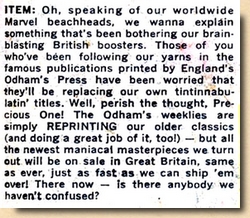
Bullpen
Bulletin, March 1968 (above)
Odhams in-house ad (below)
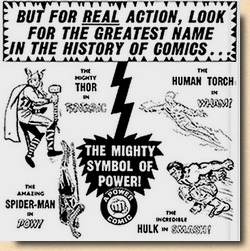
|
|
| |
|
| |
WELCOME TO THE
MIGHTY WORLD OF MARVEL
|
| |
|
| On the last Saturday of
September 1972, a new comic book appeared on
British newsagent stands. Cover dated "week
ending Oct. 7, 1972", Mighty World of
Marvel #1 heralded a fresh start for
Marvel's superheroes and the beginning of
Marvel's own UK operation. As such, the well
chosen title was both symbolic and programmatic. Marvel UK, as the House of
Ideas' British imprint would soon be known as,
finally brought some sense of order and
chronological continuity to the superhero
material reprinted for readers in the UK. This
new approach was spearheaded by Mighty World
of Marvel #1, 40 page first issue had a real
and lasting impact on the British comic book
scene, kicking off with a cover by John Buscema
and contents starting with the origin stories of
the Hulk, the Fantastic Four and Spider-Man.
|
| |
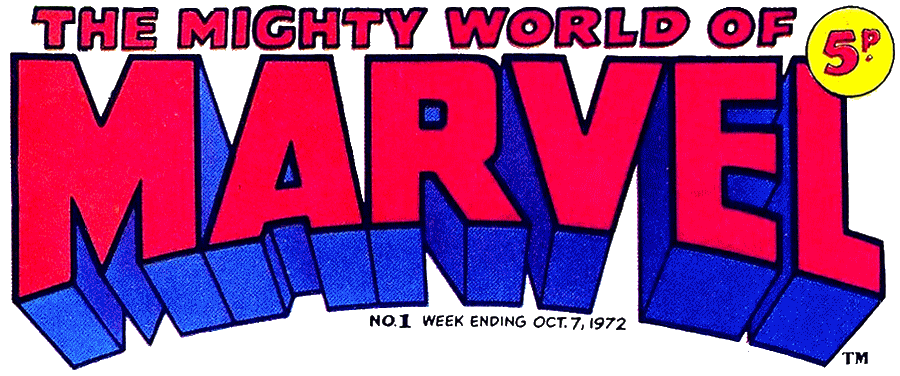 |
| |
|
| British comic books at
the time were generally published weekly, with
predominantly black and white content. The
Mighty World of Marvel - which would soon
acquire the affectionate acronym of MWOM
- followed this formula, although the first few
issues featured single tints of so-called
"spot colours" on certain pages; the
tone chosen was a light green, which at least
made perfect sense for the opening story
featuring the Hulk. |
|
| |
|
| |
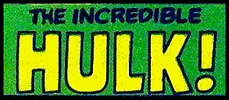
The
spot colour certainly did set aside this reprint
of Stan Lee and Jack Kirby's Hulk origin story
from its first offering to British comic book
readers, which had been published in June 1968 by
Odhams Press in Fantastic! #70 (and who,
for reasons only known to themselves, had started
the Hulk reprints in Smash! a year
earlier, in 1967, by skipping this story and
going straight to the yarn originally published
in Incredible Hulk #2).
Titled
"Part 1 - The Coming of the Hulk", Mighty
World of Marvel #1 actually fused the first
two chapters from Incredible Hulk #1 into one,
omitting the original title page to chapter 2
("The Hulk Strikes!") and thus bringing
the page count down by one to ten pages. Six of
these have the green tint (pages 1 through 5 and
page 8), four are rendered in standard black and
white.
Most readers at the time
would not have been aware of the fact that the
omission of the original second chapter's title
page wasn't, in fact, the only editorial change,
although most of them were rather subtle, such as
cropping some panels at the bottom of pages
slightly in order to fit the British page size
(which was wider than the standard US comic book
page) better.
|
|
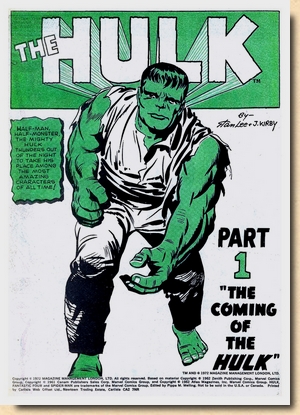
Mighty
World Of Marvel #1
(October 1972)
|
|
| |
| Page
6 from Mighty World of Marvel
#1 and Incredible
Hulk #1 illustrates this cropping, which takes quite
a bit off the bottom three panels of the original
material. On other pages, the cropping was, however, far
less noticeable. |
| |
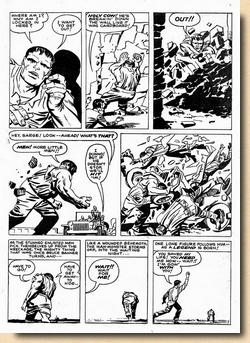 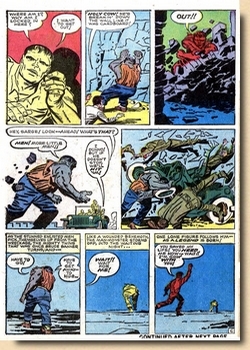
|
|
More
importantly, of course, was the change to the
colour of the Hulk's skin. Whereas the green tint
hinted at the classic green, the "jolly
green giant" had in fact been a grey giant
in his first appearance back in 1962. By the time his origin story was
reprinted in April 1968 in Marvel
Collectors' Item Classics #14, Marvel
switched the colouring to reflect the by then
established green skin.
Whilst this was of no real concern for the
spot colour / black and white pages of Mighty World of Marvel
#1, editors did fall back to the 1968 reprint -
simply because it too had split the origin story
in two and thus conveniently featured a text
blurb (obviously absent on the original 1962
page) pointing readers to the next issue.
|
|
| |
| The Hulk would prove immensely
popular with British readers, quite
possibly even outranking Spider-Man.
Not only did Ol'
Greenskin thus become the star-billed
feature of MWOM (as of issue #38 in June
1973), he also appeared on almost every
cover, week after week, over the course
of the next few years.
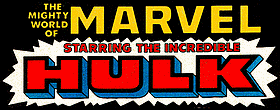
|
|
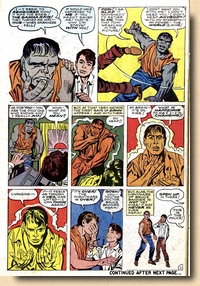 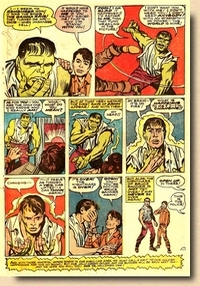 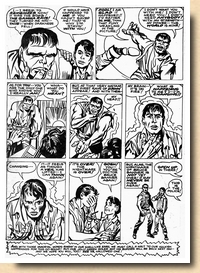
Incredible
Hulk #1 - Marvel
Collectors' Item Classics #14 - Mighty
World Of Marvel #1
|
|
|
|

As
with the Hulk story, most of the pages of the
segment featuring the origin of Marvel's First
Family from Fantastic Four #1 (November
1961) are printed with the green spot-colour
(story pages 1 through 10 plus page 13), with
only two pages in actual black and white.
Fitting three different
features into 40 pages inevitably meant that
material originally published in one single issue
had to be cut up into segments - something that
would become a characteristic trait for Marvel
UK's reprints (with only few exceptions).
As
with the Hulk segment, the FF feature thus only
features the first 13 pages of Fantastic Four
#1, i.e. their actual origin story, whereas
their subsequent encounter with the Mole Man
appeared in Mighty
World of Marvel #2. Given the weekly
publication schedule, the segmentation of
features never really felt awkward (even when it
was cut down to only five pages). It also made
sure that Marvel UK wouldn't run out of material
to reprint (something that would happen all the
same and soon enough).
|
|
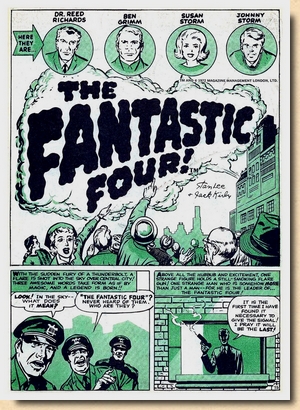
Mighty
World Of Marvel #1
(October 1972)
|
|
| |
| What does, however, set the
Fantastic Four segment apart from the Hulk's origin story
on the preceding pages of MWOM #1 are the numerous - and
sometimes quite substantial - editorial changes made to
the dialogue in comparison to the original material. On
page 25 (which corresponds to page 9 of Fantastic
Four #1), editorial not only replaced the original
"Commies" with "Russians" in panel 2
(even Odham's felt compelled to redact that, using "someone" instead for Smash!
#28 in August 1966) but actually opted to delete no less
than three speech balloons in panel 4.
|
| |
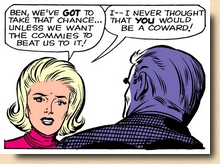 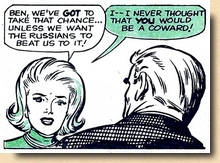 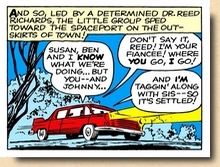 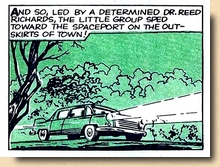
|
| |
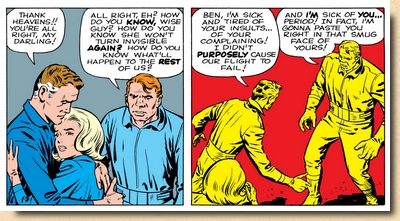
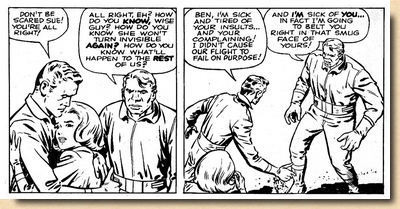
|
|
This
was done with the intention to eliminate any
mention of or referal to the relationship between
Reed Richards and Sue Storm (along with some
jealousy on the part of Ben Grimm). Exactly why
this rather core element of the FF's team
dynamics was suppressed for British readers in
1972 is anybody's guess. There was, as a
consequence, more elimination of romance on page
28 in panel 1 (corresponding to page 12 of Fantastic
Four #1), when Reed exclaiming "Thank
Heavens!! You're all right my Darling!"
is toned down to "Don't be scared Sue!
You're all right!".
The change to
dialogue in panel 2 on that same page seems just
as unnecessary - editorial obviously deemed "purposely"
as being either too American or too convoluted
and replaced it with "on purpose".
Since the
decision had been made to blot out the fact that
Sue is Reed's fiancée, further changes were
needed on that same page. In panel 5, "Run,
Reed, Darling!" becomes "Run
Kids!", and Ben's vocal jealousy is
completely changed, even resulting in a much
smaller speech bubble.
In panel 6
this then goes from "I'll prove to you
that you love the wrong man, Susan!" to
"I'll knock your block off! And then
(...)", whilst Reed's "No, you
don't!!" is changed to "Not
today you won't!".
|
|
| |
|
| |
| Possibly
judged to be adjustements that would render the FF
story better adapted to British readers, editorial input
of this kind quickly dropped to a trickle. The one
constant, however, was the substitution of the early
1960s political lingo such as "commies" and
"reds" with more neutral terms that were
somewhat more in tune with the language of the early
1970s. |
| |
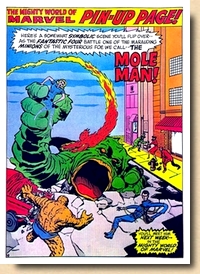
|
|
Apart from the spot
colour pages, Mighty World
of Marvel #1 also featured a
total of four full-colour pages,
one of which was to be found
between pages number 7 and 8 of
the Hulk story and featured a "Mighty
World of Marvel Pin-Up
Page".
In actual
fact this was, of course, a
reprint of the cover of Fantastic
Four #1 with a number of
alterations: All of the original
logo and cover text was dropped
and replaced with two new blurbs,
explaining that what readers saw
here was one of the
"marauding minions" of
the Mole Man - who (as per the
second blurb) would feature in
the next issue of MWOM, available
the following week.
The cover was
also recoloured for the purpose
of depciting all FF members other
than the Human Torch wearing blue
costumes, even though the cover
of MWOM #1 was the only place
where readers got to see the FF
in colour.
|
|
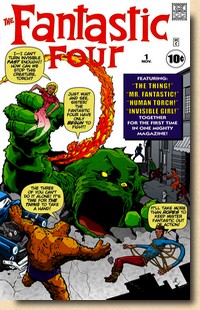
|
|
|
|
| |
| The
Fantastic Four would enjoy a very long run within the
pages of Mighty World of
Marvel (albeit always taking a back seat to the
Hulk) before moving to the (rather infamous)
landscape-format Titans in April 1976 - after
having clocked up a total of 186 issues of MWOM. |
| |
|
| |
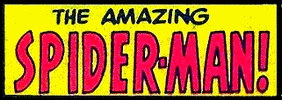
The third and final superhero
introduced in Mighty
World of Marvel #1 was Marvel's by then
flagship character: the Amazing Spider-Man.
For this
first web-swinging outing around the block,
Marvel UK went back to the actual origin story
from Amazing Fantasy #15, which had been
overlooked by
Odham's and only reprinted once before in the UK,
by Odham's chaotic predecessor, Alan Class Comics, in
October 1964 in Out Of This World #17.
The only
change made to the original material was the
omission of page 7, which was the "Part
2" title page. Most pages were reprinted in
the green spot-colour (which could actually fade
to a light blue in places), namely story pages 1
and 2 along with 5 through 9, with only pages 3
and 4 being rendered in actual black and white.
The final page, on the outside back cover, was
even printed in full colour.
Spider-Man would be the first of
the original MWOM line-up to receive his own
weekly title, Spider-Man
Comics Weekly (which would also introduce
Thor and later on Iron Man), in early February
1973.
|
|
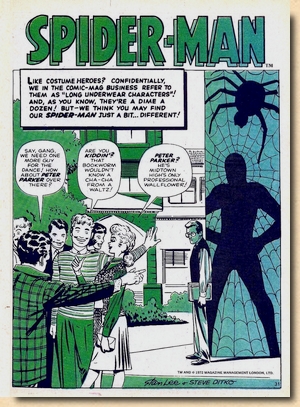
Mighty
World Of Marvel #1
(October 1972)
|
|
| |
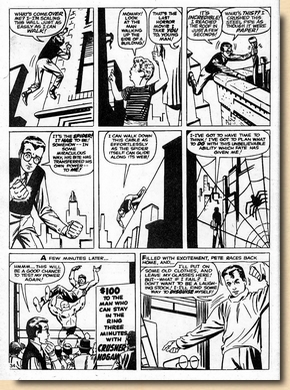 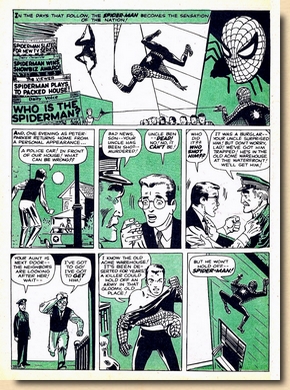 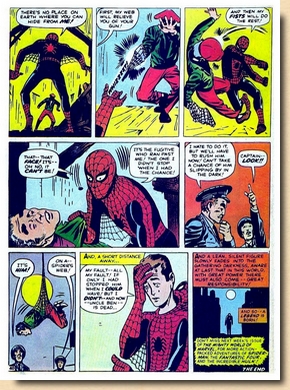
|
| |
|
| |
"WOW! WE MEET AT LAST!"
|
| |
|
Two of the three stories featured in Mighty World of
Marvel #1 had been reprinted by Odham's Press five
years prior - but this was a fundamentally different
approach. This was the real
deal, coming straight from Mighty Marvel, and the comic
book's title was, of course, programmatic - even more so
since there is pre-production evidence showing that it
may initially have been planned as "Wonderful"
World of Marvel (Cook, 2022). A big part of
accentuating all of this was presentation - and what better way to bring "Mighty
Marvel readers" up to speed with the Marvel
philosophy and the company's friendly banter with its
readership than to run a welcoming "special
message" from Stan Lee.
|
| |
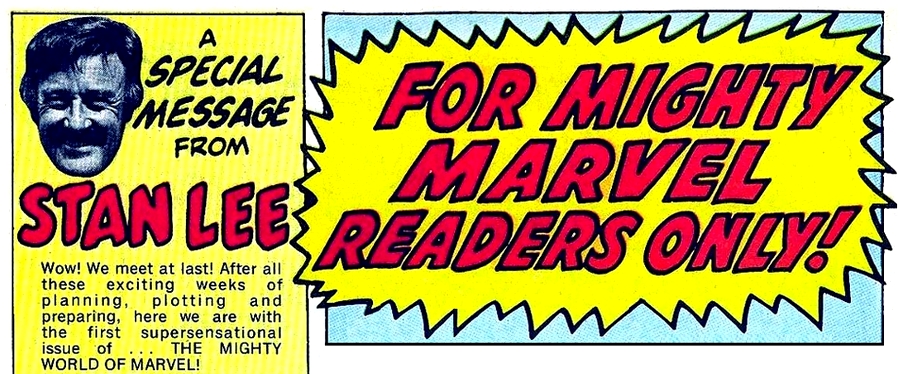 |
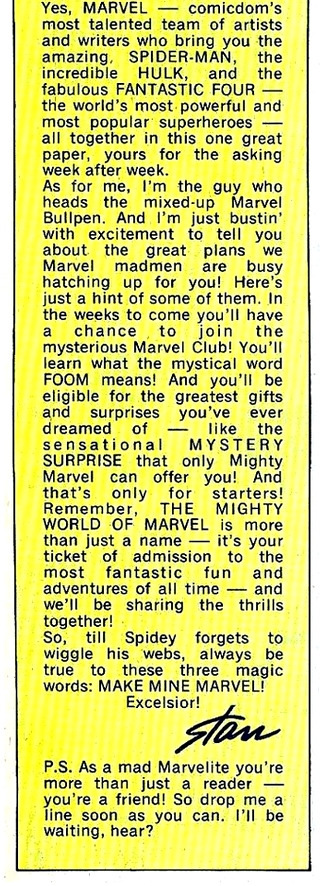 |
|
Placed on the centerfold
double-spread (pages 19 and 20) and printed in
glorious colour, Stan (not The Editor or
any other formal moniker) used his avuncular
hyperbole to let readers know that Marvel was
"comicdom's most talented team of artists
and writers" who had come up with
"the world's most powerful and most popular
superheroes". He
also made it clear that the
"supersensational" Might World of
Marvel was "more than just a name"
- it was a "ticket of admission to the most
fantastic fun and adventures of all time".
And finally, but maybe
even most importantly, Stan let readers know that
"As
a mad Marvelite, you're more than just a
reader - you're a friend! So drop me a line
soon as you can, I'll be waiting, hear?"
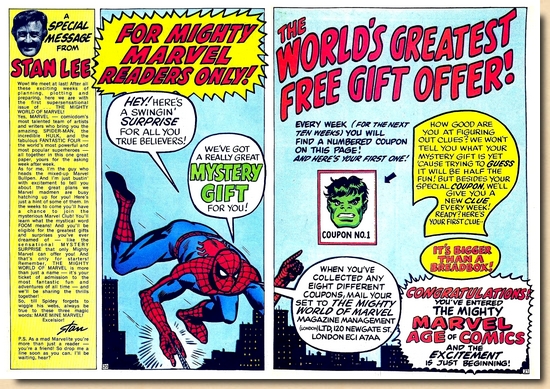
The very same
double-page editorial also greeted readers with a
blurb stating "Congratulations! You've
entered the Mighty Marvel Age of Comics and the
excitement is just beginning!"
The launch of Marvel's
UK imprint was a huge success, and a key element
was its authenticity. This was the House of Ideas
at work, and readers in the UK now got their real
share of Merry Marveldom - not only its visual
house style, but also its friendly and chatty
(often tongue-in-cheek, and sometimes waaaay over
the top) editorial style as established by the Maestro
Supreme Stan Lee. It all was essential in
creating a sense of community.
|
|
| |
Having the original and not a
watered-down copy was a first for British comic book
readers - and it struck a welcome sentimental chord with
seasoned readers accustomed to the US publications. The
"Bullpen Bulletins" were a feature of the UK
weeklies as much as they were of Marvel's US comic books,
and during the first two years of Marvel UK also
contained an anglicised version of Stan Lee's soapbox, in
which he presented news from the world of Marvel to
British readers. The style, however, was unchanged -
readers received this input ("nutty news")
on an eye to eye level ("from one Marvel madman
to another").
"What I always
tried to do with Marvel was to make it seem like a
club, like an inner group that we knew about and the
outside world wasn't even aware of. If you read
Marvel you were on the inside, you were hip, and it
was sort of an exclusive thing, limited just to
Marvel readers. And I tried to talk to the readers as
if they were friends, not readers, so that not only -
hopefully - did they enjoy the stories, but they
enjoyed being part of the Marvel mystique if you
might say, and I'm probably making it sound much more
profound than it really was, but that's the way I
looked at it (...) to let the world know about the
marvelous world of Marvel. So in that sense, I guess
I was a little bit of a huckster." (Stan Lee in NN, 2003)
Just as
their American counterparts, Marvel UK's titles also
featured regular in-house advertising - which always
served a double purpose at the House of Ideas.
|
| |
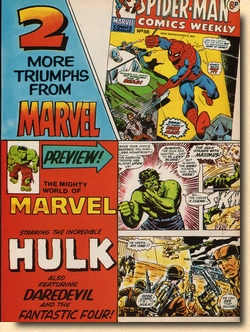
Avengers #26
(March 1974)
|
|
Firstly, it was,
of course, a way of telling the
readers of one comic book title
that there were others available
which would be just as
interesting. But secondly - and
just as importantly - the
in-house ads also served to
establish and strengthen the
Marvel house style.
Comic books
weren't just good, they were "triumphs"
and "dynamite"
from "magnificent
Marvel" on the move as
the advertising followed the same
flashy and often bigger than life
presentation seen in the stories
and in editorial copy.
Quite simply,
Marvel not only excelled at
presenting its actual product,
but just as much at presenting
itself. Set up and guided by the
master of the soapbox, Stan Lee,
Marvel were masters at impression
management, and Marvel UK was
setting out on a proven path with
Mighty World of Marvel
and other weekly titles to
follow.
|
|
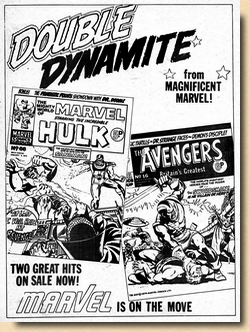
Spider-Man Comics
Weekly #47
(January 1974)
|
|
|
|
| |
| Quite often (and understandably so),
this meant more than just emulating Marvel's advertising
house style, as the following comparison between a 1970
US and a 1974 UK example shows. Lifting elements straight
off of previously used material not only guaranteed an
authentic look and feel, it also saved time and money. |
| |
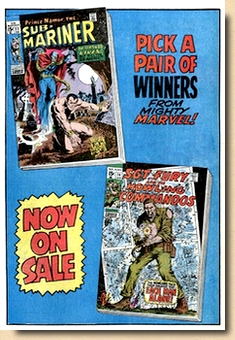 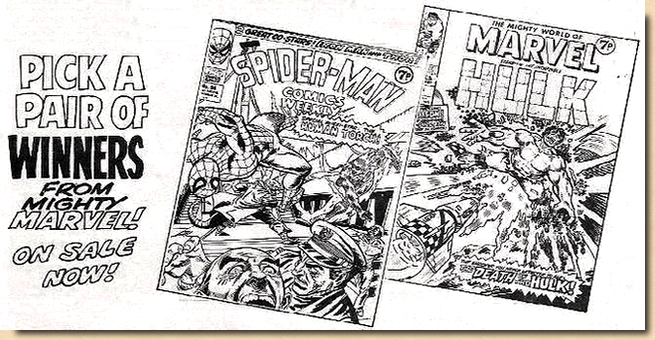
|
| |
|
| |
PUTTING TOGETHER THE MIGHTY WORLD OF
MARVEL UK
|
| |
| Mighty World of Marvel #1
was published by Marvel under the newly set up corporate
name of Magazine Management London Ltd, the imprint
affectionately labelled "Marvel UK" both by
fans and staff. |
| |
 |
| |
| Stan
Lee was heavily into an "international dream"
(Kirby, 2019) for Marvel, but nobody had originally
planned or intended for the House of Ideas to publish its
material in the UK themselves. It was only when a
collaboration deal with London based comic book
distributor Martspress Ltd (Beal, 1997) fell through -
leaving Marvel with a substantial investment at risk -
that they came to the conclusion and decision that they
would go it alone (Kirby, 2019). A
contract was already in place with Pippa Melling (née
King), who had previously worked for Odhams Press and
brought her experience in breaking down and editing
Marvel material from monthly to weekly sequences to the
project (Murray, 2017). She remained the editor of Mighty
World of Marvel, as per the indicia, up until issue
#28 in April 1973, followed for one single issue by Peta
[sic] L. Henley, and then Petra L. Skingley - possibly
one and the same person, since Petra
Skingley was later dubbed both Peter L. Skingley and
Peter Allen in the indicia (somebody must have felt that
"boys comics" should have male editors, even if
by "pen name" only). Both Melling and Skingley
were based at 120 Newgate Street in London, but Marvel UK was, to all
intents and purposes, launched and initially directed out
of Marvel's NYC offices.
|
| |
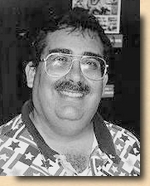
Tony Isabella
|
|
The
practical task of getting Marvel UK up
and running was handed to Tony Isabella -
a newcomer of a mere 21 years of age,
indicating that this was clearly seen as
an entry-level job (Murray, 2017).
"I
started working at Marvel Comics on
Halloween, 1972. My first job was
editing weekly reprints for Great
Britain, working very closely with
Stan Lee, Roy Thomas, and Sol
Brodsky." (Tony Isabella in
Mithra, 1997)
The strategic
side of things rested with Sol Brodsky,
one of the original three employees of
the House of Ideas (together with Stan
Lee and secretary Flo Steinberg) who was
described by Lee himself as his "right
hand" (NN, 1998). As
vice-president (operations) he was the
person overseeing Marvel UK amongst other
things such as the Marvel Books brand.
|
|
|
| |
Marvel UK was thus deeply rooted in the inner
sanctum of the House of Ideas - a UK bullpen within
the famous bullpen, so to speak, as Isabella coordinated
the necessary work out of 575 Madison Avenue, including
his own creative input.
"I
definitely wrote some of the even more absurd topper
lines for the British weeklies that Marvel was
producing around the same time, the result of our
frequently clueless UK partners thinking we should
make our weeklies look like every other British
weekly (...) this sort of disconnect between the
Marvel offices and the folks across the ocean."
(Isabella, 2017)
"Topper lines" couldn't
really be called neither the norm nor a definitive trait
of British comics at the time, and Marvel UK only used
them for a very short period of time in 1973/74 - so this
may actually have been a misunderstanding on both sides
of the Atlantic.
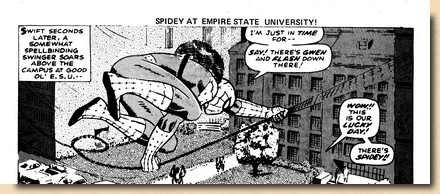 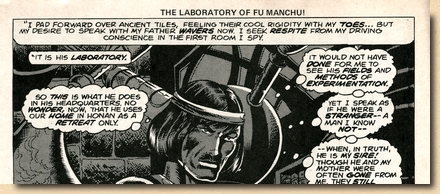
Spider-Man
Comics Weekly #47, page 2 (January 1974) / Avengers
#25, page 8 (March 1974)
They acted as
something akin to a chapter title for each page, possibly
with the intention to increase the suspense of
expectation, or - as in the examples above - or clarify
context used on that page (spelling out
"E.S.U." as Empire State University or
explaining "his laboratory" to be The
Laboratory of Fu Manchu!).
|
| |
But Tony
Isabella's statement sums up the work
distribution for the UK reprints very clearly -
anything to do with the actual content material
was handled by Marvel staff in New York (to which
Isabella kept recruiting individuals such as Tom
Orzechowski, another newcomer, who did lettering
retouches), leaving the London office to contend
with editorial chores, administration,
advertising and distribution.
The
editorial work at London's 120 Newgate Street
soon included handling the letters pages, the
first of which appeared in Mighty World of
Marvel #5, on sale the first week of
November 1972. As
the Marvel UK titles grew in number and became
more and more successful, the number of London
based English staff went up accordingly.
Holding the
reigns of the production process on the US side
of things seems to have been something of a
revolving door job. Isabella wasn't associated
with the task very long, and artist Dave Hunt,
who did some cover, splashpage and centerspread
artwork for Marvel UK, all out of the New York
City offices, recalls Marie Severin being
involved in the earlier stages of the enterprise
(Hunt & Benaka, 2018).
|
|
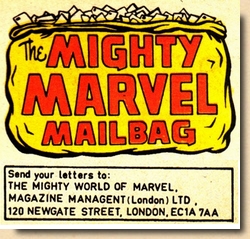
Mighty
World of Marvel #5
(November 1972)
|
|
| |
By
1974 several individuals (Pete Iro, Jim Salicrup
and David Cohen) were involved with various tasks
for the British reprints out of NYC, and in
mid-September 1976 no other than Larry Lieber was
put in charge - a fact highlighted by his brother
Stan Lee in his famous Soapbox column.
"Larrupin'
Larry Lieber (...) has also come aboard to
handle the issues which we produce for an
ever-growing army of Marvel fanatics in Great
Britain. Wouldja believe they're on sale weekly
over there; so we're bettin' that Larry'll be
kinda busy." (Stan's Soapbox, September 1976)
|
|
| |
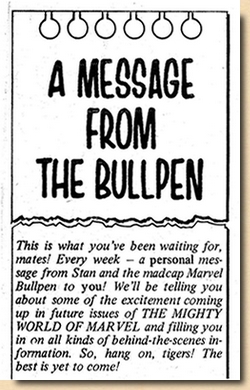
Mighty World of Marvel
#43
(July 1973)
|
|
A
sign of the growing role and importance the UK
based staff were playing was mirrored in the fact
that Mighty World of Marvel #43, on the
newsagent stands in late July 1973, featured the
first "Message from the Bullpen" - and
in this case, the Bullpen was based in London.
Whilst featuring the occasional input from Stan
Lee and news about Marvel in NYC, it contained
mostly text relevant to MWOM and Marvel UK's
operations. But Isabella wasn't
wrong inseeing some disconnect in the
transatlantic enterprise of putting together
Marvel UK. As the number of London staff grew,
the local editors would be pointing out to
readers at fairly regular intervals that certain
things were simply out of their hands and
control, since that was all "done in the
US".
A random yet
typical example of this can be found on the
letters pages of Avengers (UK)
#66
(December 1974). Comparing
the original colour material with the greytones
added to the black and white Marvel UK reprints
often revealed some problems, some of which would
even obscure the original artwork to a degree. In
reply to a reader complaining about this,
editorial stated that
"We've a growing feeling that
those against the tone are convinced that it
is added to the original Marvel pictures by
someone in England - someone not necessarily
sympatico with Marvel. Not so! The tone is
placed upon those pix in the Marvel Bullpen
in New York. Never doubt that. So now, if you
disagree with it at least you know who it is
you're disagreeing with!" (Avengers
(UK) #66 , December 1974, Letters page).
|
|
| |
|
| |
THE
IMPACT OF THE MIGHTY WORLD
OF MARVEL
|
|
| |
| The
Mighty World of Marvel
would clock up a staggering 329 weekly issues between
early October 1972 and mid-January 1979, and witness the
coming (and going) of many spin-off and companion titles.
Although retaining its numbering, it lost its
"Mighty World of" moniker and simply became Marvel
Comic as of issue #330, and as of August 1979 what
once used to be MWOM was merged with Spectacular
Spider-Man Weekly, erasing almost all traces of the
comic book that had started it all for Marvel UK. It was,
quite simply, a time when comic books generally had a
hard staying afloat, let alone being "mighty".
|
| |
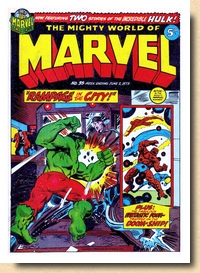
Mighty World of Marvel
#35
(June 1973)
|
|
But back
in the autumn of 1972, The Mighty World of
Marvel was a huge success in launching
Marvel's very own weekly reprint title for the
British market.
This undertaking would soon become known as
Marvel UK, and working its way from the base camp
that was MWOM, the imprint would steadily
increase its share of the British market by
launching a succession of additional weekly
titles, initally all spinning out of MWOM: first Spider-Man
Comics Weekly in February 1973, and then Avengers #1 in
September 1973. These were followed by the
simultaneous launch in October 1974 of Dracula
Lives! and Planet of the Apes.
Mighty World of
Marvel launched the Golden Age of Marvel UK,
very much true to its programmatic title. While
essentially becoming a vehicule for the Hulk as
other characters spun off into their own or new
titles, MWOM was always the hub - the mothership
from which all things Marvel UK radiated.
|
|
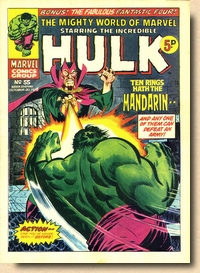
Mighty
World of Marvel #55
(October 1973)
|
|
| |
| It was therefore no surprise to see the Mighty
World of Marvel logo featured in the ads heralding
the new Dracula Lives! and Planet of the
Apes weeklies. |
| |
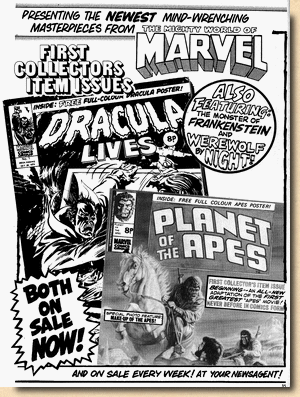
|
|
MWOM
was, quite simply, more than a weekly title - it
was in many ways the programmatic synonym for all
and everything connected to Marvel UK. So much so, in fact, that the
title went through several publisher
permutations, reaching volume
7 before being cancelled for the last time (at
least for now) in November 2019 - just before
Covid-19 wiped out all of Panini's UK Marvel
reprint titles.
The impact that Mighty
World of Marvel had on the British comic
book market in the 1970s was well served by the
recurring images of the Hulk on its covers - it
simply smashed its way into UK comic book
history, and 50 years later, these resounding
shock waves still resonate.
 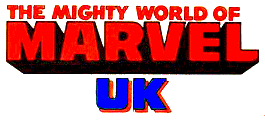 
|
|
| |
| |
|
| |
| FURTHER
READING ON THE
THOUGHT BALLOON |
| |
 |
|
There's
more on the 1970s history
of Marvel UK here,
and some closer looks at
specific titles and
issues here. |
|
|
|
|
| |
|
| |
BIBLIOGRAPHY
| |
| BEAL George
(1997) "Obituary: Leonard
Matthews", The
Independent, 5 December 1997 COOK Steven
(2022) "The Wonderful...
er, Mighty World of Marvel", Secret Oranges,
published online 25 August 2022
HUNT
Dave & Lee Benaka (2018) Dave Hunt - An
Artist's Life, Book Baby Publishing
ISABELLA Tony (2017)
"Rawhide Kid Wednesday 98", Tony
Isabella's Bloggy Thing, published online 18
January 2017
KIRBY
Roy (2019) "Stan Lee, Al Landau, & the
Transworld Connection", Alter Ego
(vol. 3) #161
MITHRA Kuljit (1997)
"Interview with Tony
Isabella",
Man Without Fear, published online May
1997
MURRAY
Chris (2017) The British Superhero,
University Press of Mississippi
NN
(1998) "Roy Thomas Interview", in The
Jack Kirby Collector #18
NN
(2003) Stan Lee Interview, contained as
extra feature on the double disk DVD release of
the movie Daredevil (personal
transcript)
|
|
| |
|
| |
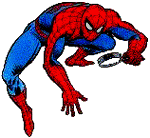

(c) 2022
uploaded to the web
17 September 2022
|
| |
|
|


























